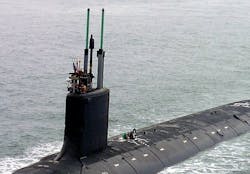Navy orders additional submarine electro-optical imaging sensors from Lockheed Martin
WASHINGTON, 3 Dec. 2015. Lockheed Martin Corp. will provide the U.S. Navy with two advanced open-systems submarine electro-optical imaging systems under terms of an order announced this week that with options could turn out to be worth as much as $57 million.
Officials of the Naval Sea Systems Command in Washington announced a $7.2 million the Lockheed Martin Mission Systems and Training segment in Manassas, Va., to provide two AN/BVY-1 Integrated Submarine Imaging Systems (ISIS) and spare parts.
The ISIS provides mission critical, all-weather, visual, and electronic search, digital image management, indication, and warning for U.S. fast-attack and cruise-missile submarines. The order has options that could increase its value to $57 million.
ISIS, which interfaces to Virginia-class, Seawolf-class, and Los Angeles-class fast-attack subs, as well as Ohio-class cruise-missile subs, provides a flexible architecture for inserting future capabilities as they become available, Navy officials say. The system has the potential for installation on Ohio-class ballistic missile submarines and other kinds of submarines.
ISIS is a back-fit system to integrate all imaging capabilities on existing Navy submarine classes. It is part of the Navy's submarine Photonics Imaging System, a non-hull-penetrating replacement for existing optical periscopes.
The Photonics Imaging System uses a wide portion of the electromagnetic spectrum with advanced daylight cameras, infrared thermal imaging sensors, and communications intercept and electronic warfare support.
The ISIS program seeks to replace the optical light path of existing submarine periscopes with high-definition cameras and fiber optic digital imagery. the project seeks to use infrared cameras for image enhancement, provide active and passive range finding control, and install image enhancement capabilities and analysis tools for real time and recorded imagery.
The ISIS program also will provide Navy submarines with image recording, storage, and recall capabilities, as well as provide the ability to transmit imagery off the submarine to other naval and joint forces.
In-Depth Engineering Corp. in Fairfax, Va., under subcontract to Lockheed Martin, serves as the software development lead for AN/BVY-1 system.
ISIS revolutionizes Navy submarine surveillance capabilities by integrating digital video and still images from devices on a submarine's exterior and presenting real-time imagery and analysis on existing control room tactical displays.
Related: Not your grandfather's submarine periscope
ISIS provides digital image enhancement for data from a modern submarine's photonics mast, which uses optical fiber to move imaging data from a raised mast aboard a submerged submarine through tiny openings in the submarine's hull to tactical displays around the interior of the vessel.
The photonics mast replaces or augments the traditional periscope aboard U.S. submarines. The photonics mast not only replaces the large opening in the submarine pressure hull necessary for the optics and hydraulics of a traditional periscope, but also can blend image data from several kinds of electro-optical sensors aboard the photonics mast, including visible-light and infrared cameras.
The ISIS system enables submarine crew members to manipulate a photonics mast with a joystick, while looking at digital video on a computer monitor, and share that video real-time with the submarine's combat team on various displays aboard the vessel.
On this contract modification Lockheed Martin will do the work in Manassas, Va.; Northampton, Mass.; Marion, Mass.; and Chantilly, Va., and should be finished by November 2017.
For more information contact Lockheed Martin Mission Systems and Training online at www.lockheedmartin.com/us/mst, In-Depth Engineering Corp. at http://in-depthengineering.com, or Naval Sea Systems Command at www.navsea.navy.mil.

